1876–1880
June 24, 1876: Forest Park officially opens to an estimated 50,000-strong crowd. Consisting of 1,371 acres of St. Louis countryside, Forest Park exceeds New York's Central Park by more than 500 acres. Ulysses S. Grant was president and, on the same afternoon, General George Armstrong Custer was massing his troops to attack Sitting Bull and the Sioux nation near a small Montana stream called the Little Big Horn. On this Saturday afternoon during the nation’s centennial, Forest Park officially opened to the public and was dedicated at a large public ceremony.
The 1876 plan of Forest Park. Because of shortages of time and money, the commissioners were unable to supply some of the planned features, such as the Cascades, pictured upper left.
During this time, urban areas suffering from the residual effects of the industrial revolution, created environmental issues ranging from heavy smog to acid rain.
St. Louis was one of the most adversely affected cities; and many health professionals praised the clean air of the less developed countryside (which the Park was then considered) as beneficial to city-dwellers.
Built with the intent to match the grand public parks of Europe and other US cities (namely New York’s Central Park, which was established in 1853) Forest Park was the vision of a number of progressive locals who felt the St. Louis public wanted was a park that:
“the rich and poor, the merchant and mechanic, the professional man and the day laborer, each with his family and lunch basket, can come and enjoy his own . . . all without stint or hindrance . . . and there will be no notice put up to, 'Keep off the grass.'”
“We lived near Forest Park. My mother would take us children there on a hot night and lay a blanket on the grass, and we would fall asleep in the cool park.”
Founders of Forest Park negotiated public transportation to the area in the form of a train from downtown, bringing thousands of visitors to the Park each day. In addition, in the first years of the Park’s existence, 19 miles of gravel roads were laid at a cost of $16,000 per mile.
1881–1890
1885: As the city spread further west and encroached upon the eastern border of the Park, streetcar lines were extended to Forest Park, and hundreds of thousands of people began visiting each year.
Prior to the arrival of streetcars in summer of 1885, the only public transportation remained by train. This limited the numbers of people who used the Park primarily to those on horseback or in vehicles of some kind. Even for people who rode in carriages or on horseback, the trip was dusty and hot in the summer months, muddy and buggy in fall and spring.
Under new management and a stretched budget after becoming an entity of the newly separated St. Louis City, Forest Park officials struggle to continue developing recreational areas and support structures.
Areas that prospered, however included the nursery, which was established to provide plants and landscaping, and the Missouri Fish Commission’s fish-rearing operations, whose carp-spawning operations grew so large that the fish were used to populate lakes throughout the state.
A horse and buggy in Forest Park
1891–1900
1894: The Post-Dispatch undertakes fundraising efforts to extend the Park’s main lake (explaining the name Post-Dispatch Lake). Donations exceeded $19,000 at a time when $1.00 would buy 50 pounds of flour and a man’s suit cost about $7.50.
1896: The seven streetcar lines serving Forest Park carry more than 2.5 million Park-goers a year. Two pavilions abutting streetcar lines, the Lindell Pavilion and the Laclede Pavilion, were built in the early ’90s to accommodate the crowds. The Laclede Pavilion was torn down in 1938; the Lindell Pavilion partially burned down in 1924 and has been restored in a variety of capacities, finally as a visitor and education center for Forest Park.
Boating on Post-Dispatch Lake
Original Lindell Pavilion
1896: The Forest Park Highlands Amusement Park opens. Once St. Louis' largest and best-known amusement park, the Highlands boasts a fine theater and one of the largest public swimming pools in the United States.
A special thank you to Doug Garner for more Highlands Amusement Park information and photos. Visit his website for much more.

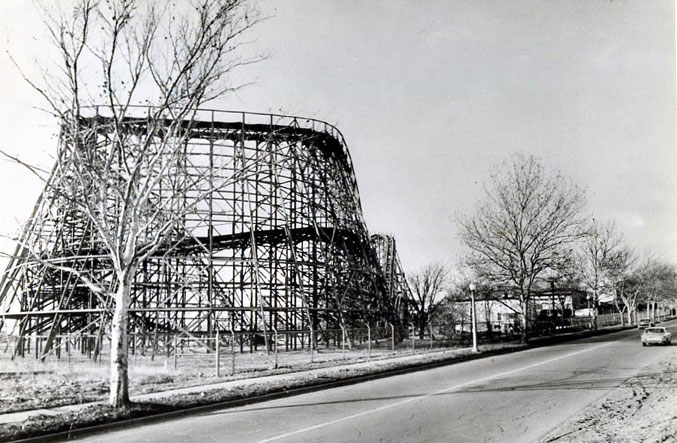
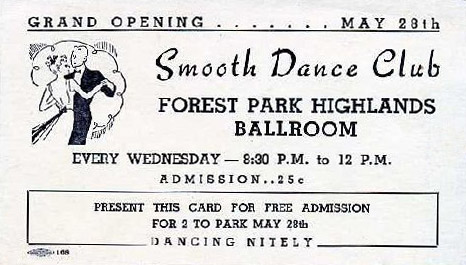
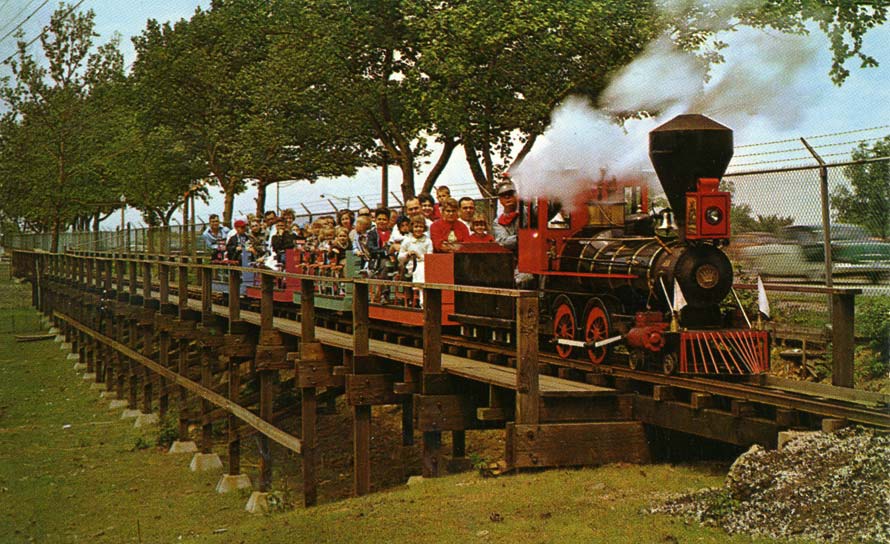
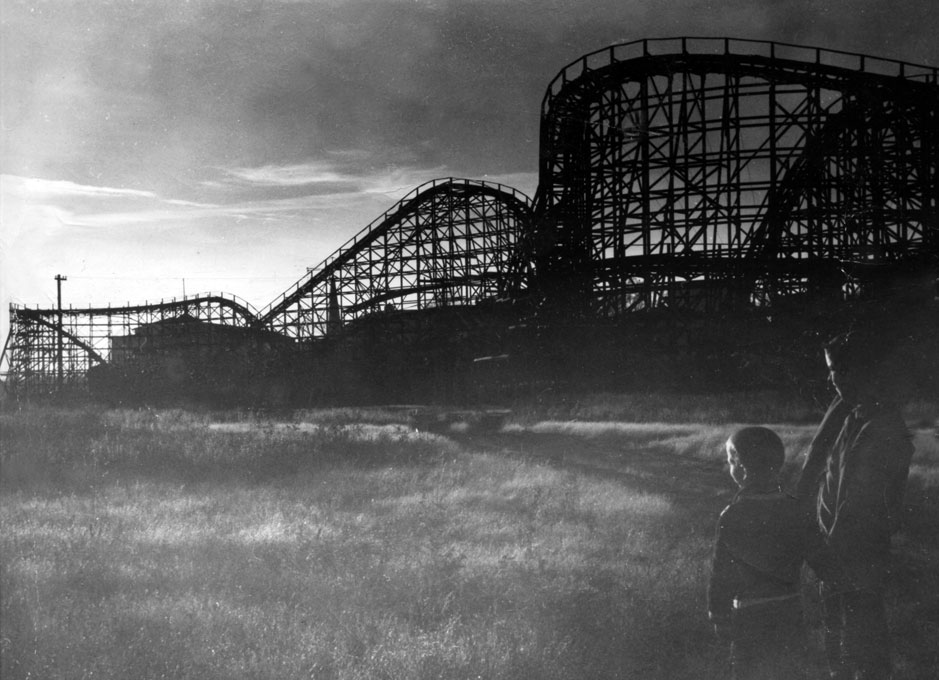
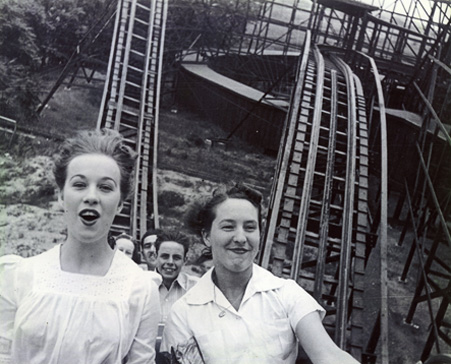

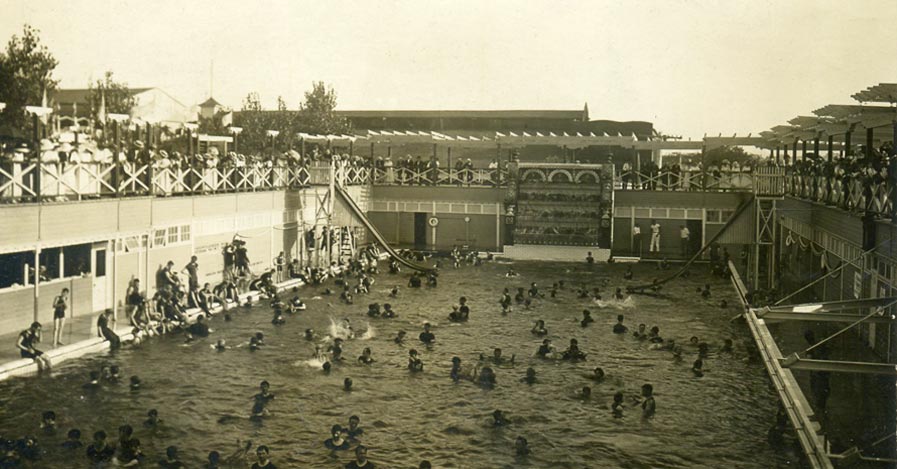
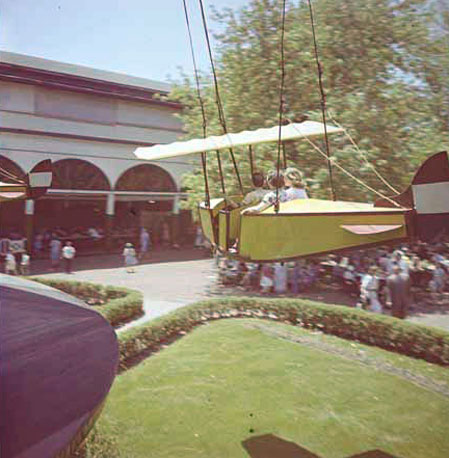
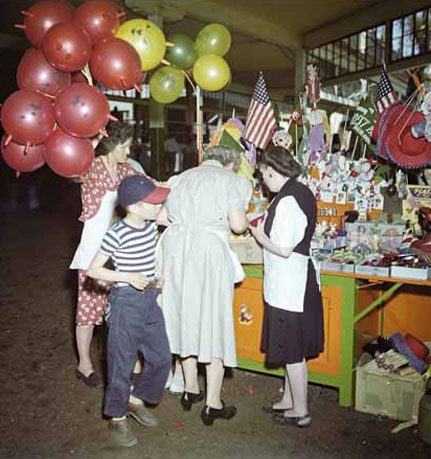
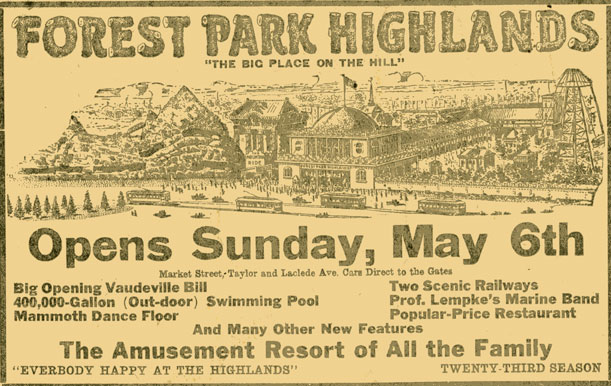
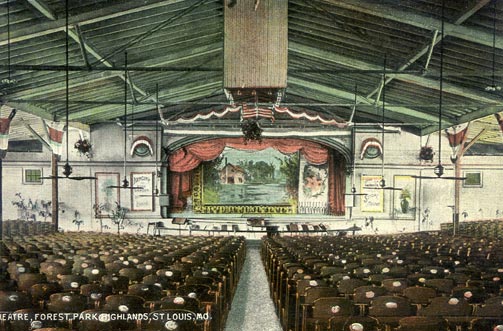
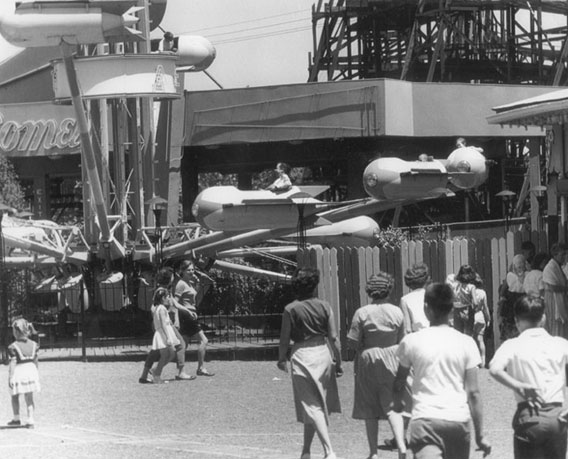
“What fond memories I have of the school picnics we had at the Forest Park Highlands. My whole family would go to the Park and we rode every ride, ate till we were ready to burst, and rode some more. It was a sad day when I stood on my porch and watched the smoke blacken the sky as it burned. Many wonderful memories were brought back that day for me as a child. The Zoo is one of the best in the world, and everyone should remember Phil the Gorilla. Even though I no longer live in St. Louis, it is still my hometown. ”
Developers’ visions of a fashionable neighborhood surrounding Forest Park came to fruition as private streets took hold north and east of the Park in what came to be known as the Central West End.
1900: St. Louis developers and politicians successfully lobby for the city to host the 1904 World’s Fair. Despite initial suggestions that the Fairgrounds be placed downtown, officials eventually secure the Park as the official grounds.
“As a child my mother lived with her family in a big old house on Grand Avenue and Flad. She vividly remembered Sunday rides in their open carriage in the summer evenings when they went to Forest Park and to the small pavilion in front of the Muny Opera to hear musical events, before the Muny was even built. Once, on the ride back home, she fell asleep with her little hand hanging out of the carriage, and lost her favorite ring. It all seems so long ago, and I guess it was. She was born in 1898. Her name was Eugenia Marguerete Rose Uhri, later married to James A. Maritz.”
1901–1910
1904: The Fair is a tremendous success! More than 20 million attendees visited the Fair between April 30 and December 1, 1904 — upwards of 100,000 people per day. However, the wear and tear on Forest Park is noticeable and the next seven years are spent putting the Park back together.
World's Fair Canal
Washington University, which was constructing its main administration buildings at the time, agreed to delay moving into the buildings until after the Fair. The University loaned what is now known as Brookings Hall to the Fair for its administrative headquarters.
The School and Museum of Fine Arts, also a branch of Washington University, was completing its plan to build a museum in the Park when it was determined that the Fair would have to have a permanent, fire-proof structure for its Palace of Fine Arts. The groups got together and determined that the building, constructed upon the Park’s highest hill, would be handed over to the School and Museum after the Fair. The Museum (now the Saint Louis Art Museum) is the only Fair structure in this area that remains standing today; all other exhibition palaces were temporary, built of plaster and wood.
In all, more than 900 structures were built to house exhibits from 22 countries and 44 U.S. cities, concession stands, concerts and more. The city also hosted the 1904 Olympics, the third of the modern era, and the first-ever in the U.S.
January 8, 1905: World's Fair workers grabbed folding chairs and rode them down Art Hill after a snow storm, creating a St. Louis tradition for the next 109 years. Read this St. Louis Post-Dispatch article for more
1911–1920
1911: Dwight F. Davis became Parks commissioner. Davis was an enthusiastic proponent of recreational and athletic activities.
1912: The first official public golf course in St. Louis opened in the Park. It was soon expanded to 18 holes and another nine-hole course was added. Davis also built 32 public tennis courts.
1917: A coalition raised the funds and interest to build the Municipal Theatre, or the Muny, as it came to be known. The 10,000-seat theatre’s first productions were "Aida" and "I Pagliacci."
1918: The City of St. Louis set aside land on the South side of the Park for a landing field for airmail service, also erecting a hangar that currently serves as the headquarters for the Mounted Police. The airfield was used as a mail delivery stop for less than a year, after which private pilots used the facility for exhibition flights.
1919: The Muny’s summer season is offically initated. From the very beginning, free seats were offered within the theatre and above the seats on the grass.
Dwight F. Davis, Former Parks Commissioner
Construction of The Muny
Forest Park Mounted Police Division
1921–1930
The Saint Louis Zoo saw significant enhancements during the 20s. The natural looking bear pits, constructed of concrete and using cast molds of limestone bluffs above the Mississippi near Herculaneum, were added in the early 20s. They received national recognition for their natural appearance. The Zoo’s Primate House opened in 1925; the Reptile House in 1927.
1923: After the River des Peres was deemed a "inexcusable nuisance" by the Missouri Supreme Court. St. Louis residents pass a bond issue, permanently sending it underground forever. A man-made river was later installed in the Park as part of the Forest Park Master Plan.
1925: After a storm and fire damaged the original bandstand, U.S. Rep. Nathan Frank stepped up with the money to rebuild the centerpiece of Pagoda Circle. With his gift, he encouraged others to support the Park and described the reasons for his own support this way: "All that I have, all that I have acquired, I owe to St. Louis." Today, the Forest Park Forever Nathan Frank Society is named in his honor.
June 19, 1927: 100,000+ people jammed Art Hill to welcome Charles A. Lindbergh back to St. Louis after his nonstop flight from New York to Paris. Though Lindbergh had lived in St. Louis only two years, he made the city world famous by naming his plane the Spirit of St. Louis at the request of a group of businessmen who had funded his aviation efforts.
Original Pagoda Circle
Lindbergh addressing a crowd on Art Hill
1929: Before the highway was constructed, cutting it off from the Park, the St. Louis Arena opened adjacent to the Forest Park Highlands Amusement Park. With floor room for seating for 21,000, it was the largest building of its kind in the world, and boasted more floor space than Madison Square Garden.
1931–1940
Both Seven Pools (located near the Park's southeastern corner) and the Cascades (located across the street from the lower golf course) were added to Forest Park.
November 14, 1936: The Jewel Box is opened and dedicated. It later achieves national recognition for its design. The project cost more than $100,000 and was paid in part with from the Public Works Administration program.
“ . . . That was a wonderful evening. We danced, I sparkled, Joe glowed; we were happy. The next day, we all went to Forest Park. Inside the Jewel Box somebody took a picture of us standing on either side of a lamppost. Afterward, we would tell people that picture was taken on the very day that we realized we were in love with each other!. . . Forest Park has been a place of magic for me and for my family ever since that unexpected weekend visit during a time of war and uncertainty. I love the place.”
1930: Electric boats were introduced in the Grand Basin and were so popular that people sometimes waited until after midnight to rent one.
1941–1950
During World War II, Forest Park housed a recreation camp for men on weekend leave; the camp could accommodate up to 1,500 white servicemen. The Army Recreation Camp for Negroes, however, was more than a mile away at Spring and Chouteau. After the war, Black and white workers joined to end segregation in uses of the Park’s facilities, including the tennis courts and golf courses.
1948: Seating at the Muny is desegregated and was peacefully opened to all.
It was during the 1940s that the Muny altered its selection of popular shows, versus traditional opera, and attracted national attention, at the same time that outdoor theatres across the country were closing down.
Fortune magazine noted that the Municipal Opera “probably has no counterpart anywhere; it seems to appeal to almost everybody.”
It was also during this decade that the Muny received significant architectural improvements, including the circular box office that still operates today.
1951–1960
The Muny continued to do well in the 1950s. Time magazine attributed the Muny’s continuing popularity and financial success to “the quality of its performances. Even an out-of-town critic from Dallas admitted that St. Louis’ municipal opera is to summer operetta companies "what the Metropolitan is to grand opera. Unlike the Met, however, the Muny has no deficit.”
1955: Forest Park received its largest single donation in its first hundred years, for construction of the Mark C Steinberg Memorial Skating Rink.
The private donor made the gift with the stipulation that the rink be open to all people, making it one of the few desegregated venues in St. Louis at the time.
1957: Steinberg Memorial Skating Rink opens to the public with state-of-the-art facilities that could be used throughout winter, regardless of weather conditions.
1961–1970
It was during the 1960s that the Saint Louis Zoo finally separated itself from the land surrounding it, and built entrances and the serpentine wall to differentiate the Zoo’s land from the rest of the Park.
1963: The Saint Louis Zoo Train began operating, providing an enjoyable ride, a rest for the feet, and additional revenue for the zoo. The Planetarium opened to the East of the Zoo. Like all other Park attractions, the Planetarium was open and free to the public, and charged a nominal fee only to view the Star Show.
1968: Tens of thousands of white and black St. Louisans attended a memorial service in the Park after the assassination of Dr. Martin Luther King. The service concluded a march that began at the riverfront Arch. City organizers planned free bus service back downtown and throughout the city from the Park to prevent any skirmishes, and many attribute the planning to the lack of violence that was witnessed in other cities.
1971–1980
1971: The Metropolitan Zoological Park and Museum District is created to establish a property tax to support the Saint Louis Zoo, Saint Louis Art Museum and the Museum of Science and Natural History, later known as the Saint Louis Science Center. Voters said 'yes' to this tax, and the ZMD, as it's known, began operations in 1972. Today, tax revenue also supports the Missouri History Museum and the Missouri Botanical Garden.
1976: Big Cat Country opened at the Saint Louis Zoo and won the American Association of Zoological Parks and Aquariums prize for the best new exhibit.
That same year the Saint Louis Art Museum began renovation of the east wing and announced plans for a new wing surrounding the earlier auditorium addition. The renovated wing opened in 1977.
1981–1990
It becomes apparent to the St. Louis community, including City officials and neighborhood groups, that Forest Park is inadequately funded, with years of deferred maintenance taking their toll, threatening to let this storied destination slip into permanent neglect and disrepair. Increased funds would be required to repair and improve the historic structures, recreational facilities and complex ecological systems within the Park. It was critical that Forest Park remain beautiful and accessible.
1986: Forest Park Forever, a private, nonprofit organization, was founded in 1986 to work in partnership with the City of St. Louis Department of Parks, Recreation and Forestry to make Forest Park the finest urban park in the nation. Initial efforts by Forest Park Forever raised money to make improvements upon existing facilities within the Park.
Over the next several years, money was raised by Forest Park Forever for specific projects, including repairs to the Victorian Bridge, renovation of the Nathan Frank Bandstand and re-lighting and renovation of the statues in the Park. Private funds were used to landscape and re-grade the Rugby Field, install 30 new park benches, provide family picnic pavilions, plant hundreds of new trees and provide for emergency maintenance needs.
1991–2000
1995: The City of St. Louis adopted the Forest Park Master Plan to integrate the Park’s natural and man-made systems into a cohesive and mutually beneficial ecosystem. The goal of the Master Plan is "to create a total park experience" that stimulates the mind, body and spirit through a variety of natural, cultural, educational and recreational facilities, opportunities and amenities. Most importantly, the plan was realistic and attainable.
1996: Forest Park Forever and the City of St. Louis launch the Restoring the Glory campaign to raise $94 million for Park renovations.
2001–2010
2003: After years of decline, the Jewel Box re-opened to the public and introduced new features to allow the facility to host special events.
2003: The dramatically restored Emerson Grand Basin becomes a St. Louis landmark, providing a backdrop for countless graduation, prom and wedding photos each year.
June 2003: Private gifts fund new construction on the Boathouse, adding a restaurant, an event space and another unique feature to Forest Park.
2004: The Forest Park Connected Waterway System, Emerson Grand Basin and Post-Dispatch Lake are recognized by the American Society for Civil Engineers for Outstanding Civic Engineering Achievement.
2005: The Jewel Box Conservatory earns a Merit Award for Landscape Architecture and Design from the American Society of Landscape Architecture.
2011–2020
The Forest Park Explorer navigates Forest Park
2011: The Forest Park Explorer emerges in the Park, carrying 88,000 riders its inaugural season.
2012: The World’s Fair Pavilion is voted “Best View of Someplace Other Than Downtown” by the St. Louis Riverfront Times
2013: Forest Park is named a "Frontline Park" by City Parks Alliance
2013: Forest Park is named a "Great Public Space" by the American Planning Association.
2015: Forest Park Forever announces Forever: The Campaign for Forest Park’s Future.
2017: Government and Wells Drives reopen after six months of major renovations.
New stone entry marker at Wells Drive
2018: Forest Park Forever concluded Forever: The Campaign for Forest Park’s Future, raising more than $139 million in gifts and pledges from the community to expand the endowment for Forest Park and raise at least $30 million for urgent improvement projects in partnership with the City of St. Louis.
2019: Forest Park Forever and the City of St. Louis announce reopening and dedication of the improved Emerson Central Fields.
2019: Forest Park Forever and the City of St. Louis break ground on a 17-acre experiential Nature Playscape in Forest Park.
2019: Forest Park Forever and the City of St. Louis announce the reopening of Boeing Aviation Fields after $3.3 million in improvements.
2019: Forest Park Forever and the City of St. Louis announce designs for transformative improvements and connections to the Park’s east waterways.
2020: City of St. Louis Parks Division and Forest Park Forever announce opening of new World’s Fair Pavilion comfort station and gathering plaza.
2021–2026
LIttle ones enjoy the first day of play in the Anne O’C. Albrecht Nature Playscape on June 2, 2021
2021: New and improved Variety Wonderland Playground reopens ahead of schedule.
2021: Forest Park Forever and the City of St. Louis celebrate the opening of the Anne O’C. Albrecht Nature Playscape.
2021: Forest Park’s new Oakland Avenue Playground opens to the public.
2022: Forest Park named the best city park in the country by USA TODAY.
“The Nick” basketball courts were dedicated on July 13, 2024
2023: Turtle of Merit: Oakland Avenue Playground receives ASLA design award.
2023: USA TODAY names Forest Park the country’s best city park for second year in a row.
2024: Forest Park Forever, the St. Louis Department of Parks, Recreation, and Forestry, the Missouri Department of Conservation and volunteers from the Kennedy Woods Advisory Group (KWAG) celebrate 25 years of restoration work in the Kennedy Forest Savanna.
2024: The Nicholas J. Booker Basketball Courts (“The Nick”), the first courts in Forest Park, open to community praise and celebration.
May 16, 2025: An EF-5 tornado devastated the St. Louis region, touching down in the western and northern ends of Forest Park.
2025: Waterway in Forest Park’s east reopens with new views, commemoration of Forest Park Forever co-founder Caroline Loughlin.
2025: The Glade takes shape in eastern Forest Park as fundraising continues.
2025: Renovation of the Boathouse in Forest Park gets underway with community input.
December 13, 2025: The Yours Forever: Forest Park at 150 exhibit opens at the Missouri History Museum.
2025: Forest Park Forever and the City of St. Louis announce the redesign of the Lagoon Drive entrance to Forest Park and restoration of the Musician’s Memorial Fountain.
2026: Forest Park Forever celebrates 40 years of partnering with the City of St. Louis to restore, maintain and sustain Forest Park as one of America's great urban public parks!
June 24, 2026: Forest Park turns 150! 🎈
















